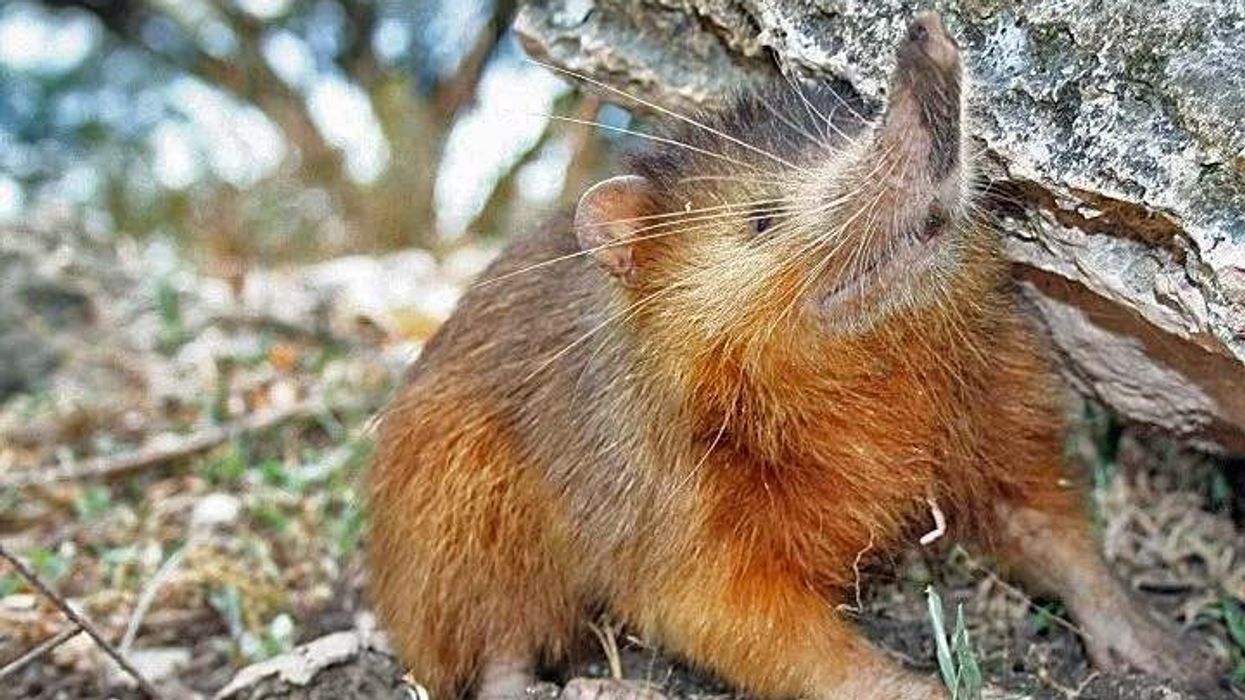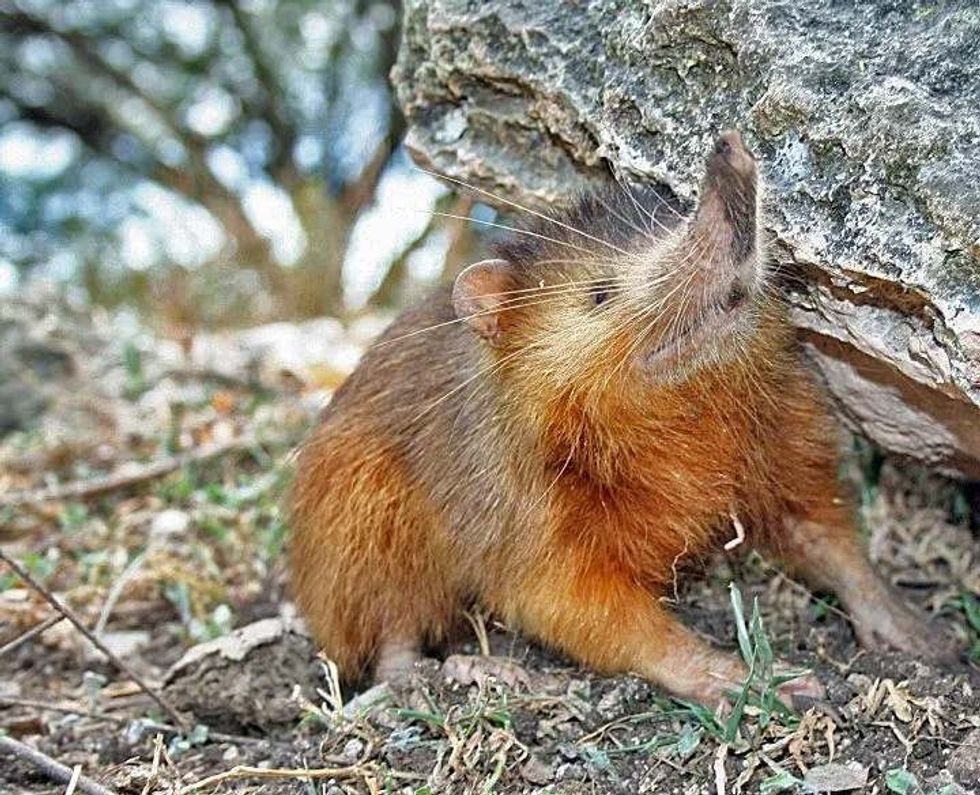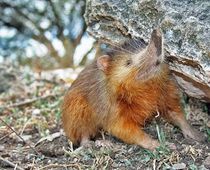Fun Solenodon Facts For Kids

Solenodons are mammals that resemble shrews and can mainly be found on the island of Hispaniola and Cuba. The island of Hispaniola includes both Haiti and the Dominican Republic.
They are endemic to the Caribbean and live in various habitats such as forested and wooded areas, caves, and scrubland. Their selection of habitat mainly includes two main factors: the availability of prey and refuge.
There are two main types of solenodons that are currently in existence, the Solenodon paradoxus (Hispaniolan solenodon) and the Solenodon cubanus (Cuban solenodon). While the former group is fortunately in the Least Concern category, the latter is endangered.
In terms of their behavior, they are not extremely aggressive, but their venomous bite is used to fatally wound or kill their prey.
Their snake-like bite and venom are mildly dangerous for humans. This animal has a lengthy history from millions of years ago.
An immense amount of research is required to know more. To know more about solenodons, keep reading!
If you would like to research more about similar species, you should check out porcupine facts and agouti facts.
Solenodon Interesting Facts
What type of animal is a solenodon?
Solenodons are mammals that resemble shrews and have two dominant species that are currently in existence. The first species is the Cuban solenodon (Solenodon cubanus), which is currently categorized as Endangered by the IUCN Red List site and on the edge of extinction.
The other species is the Hispaniolan solenodon (solenodon paradoxus), which is fortunately in the Least Concern category. These animals are venomous as they have saliva that can potentially cause fatal injuries in predators and prey alike.
What class of animal does a solenodon belong to?
The solenodon is a mammal that belongs to the Mammalia class. It is a part of the Solenodontidae family and is mainly found in Cuba, Haiti, and the Dominican Republic.
How many solenodons are there in the world?
Solenodons are thought to have come into existence around 76 million years ago at the final stages of the Cretaceous period when evolutionary causes led them to diverge from other mammals and come into their own.
There are currently no verifiable estimates related to the current population of solenodon, however, they have been thought to be extinct multiple times in the past.
Where does a solenodon live?
These mammals used to be present all over the North American continent, however, that has drastically changed in the present. Today, this venomous group resembling shrews can only be found in certain locations including Cuba, and the Island of Hispaniola, which currently constitutes the Dominican Republic and Haiti.
What is a solenodon's habitat?
Solenodons can be found in various habitats where they are allowed to burrow or attain coverage. They are predominantly found in forests, bushy and wooded areas, and caves. These nocturnal mammals build tunnel systems in the wet soil to seek shelter and find a place to store the food that they have foraged.
Who do solenodons live with?
These nocturnal mammals are generally social creatures. They choose to live with several others in deep underground burrows after they reach maturity and gather together for specific purposes. Solenodons gather purposes such as breeding and nursing. Mothers tend to care for their young until they become adult solenodons, with little input from male members.
How long does a solenodon live?
Although the average lifespan for this species is not known, a Hispaniolan solenodon has previously lived up to 11 years in captivity, while the Cuban solenodon has been known to live for at least five years.
How do they reproduce?
This animal only produces two litters a year, if there is a third litter, chances are that they will most likely die. They don't have a specific breeding season, rather, they tend to breed all year long.
Females end up nurturing and caring for the young after they have been born, a process that males do not take any part in. The period of nursing is generally 75 days. Their gestation period usually lasts for 50 days.
What is their conservation status?
The IUCN Red List has listed the Hispaniolan solenodon under the Least Concern status, while the Cuban Solenodon has been listed as an Endangered species.
Solenodon Fun Facts
What do solenodons look like?

The solenodon parodoxus, as well as the solenodon cubanus, both have chunky small bodies and legs that are slightly small and stocky. The latter is slightly smaller than the former species.
Cubanus is rusty brown and has black markings on its back and throat, whereas paradoxus tends to be a shade darker and has yellow markings on its face. Their snouts are flexible, and they also possess a joint that resembles that of a human elbow.
This mammal resembles a large shrew and has a long scaly tail, a cartilaginous snout, small eyes, and hairless feet. The snouts help males and females forage a new site or hunt for new prey.
They also have venomous saliva present in their salivatory glands, which allows females and males to defend themselves from predators. They are able to transport the venom through the grooves present in their second lower pair of incisors.
How cute are they?
These animals are pretty cute in appearance since they resemble hedgehogs. However, their cute appearance can be deceiving, since they are venomous mammals. They transport the venom through their saliva and cause the recipient to experience paralysis, shallow breathing, depression, and in worst-case scenarios, even death.
How do they communicate?
These animals mainly communicate through different types of vocalizations. They have been heard making very distinct sounds such as clicks, squeals, chirps, and twitters. Their calls often resemble those of birds, and they have also been heard making grunting sounds like pigs. Another way that this mammalian creature from the Solenodontidae family communicates is through tactile and chemical methods.
How big is a solenodon?
When describing the length of this species, there tends to be a distribution between the upper body part that extends from the head to the hump, and their tail. The length of their body is usually between 11-15 in (28-38.1 cm), whereas their tail is between 7-10 in (17.7-25.4 cm).
They are often termed as 'oversized shrews'. In comparison to shrews, they are pretty large. The average size of a shrew is between 2.2-3.2 in (5.5-8.1 cm).
How fast can a solenodon run?
Members of this species are not known for their speed as they generally waddle and have a slow and awkward gait. In most cases, especially in captivity, it has been observed that this species also has a hard time jumping, unlike hedgehogs that can easily exhibit this activity.
However, they are known to run and climb very fast when it comes to shorter distances.
How much does a solenodon weigh?
The average weight of a solenodon is between 1.8-2.4 lb (0.81-1 kg). The weight of these animals depends on their diet, health, and location. Their weight is very similar to hedgehogs, who weigh between 0.88-2.64 lb (0.4-1.2 kg).
What are the male and female names of the species?
There are no specific terms that are used to differentiate between male and female solenodons. They are simply referred to as male solenodons and female solenodons respectively.
What would you call a baby solenodon?
Baby solenodons are mainly referred to as young during their infancy. When females provide offspring, they are called young until they mature into adults. There are no other species-specific references that are used for this animal.
What do they eat?
This species mainly consumes insects, invertebrates, and earthworms, as well as vertebrate species like amphibians and reptiles. Aside from eating prey, this group of animals also consumes vegetables, roots, and fruits.
In captivity, these animals only drank water when they were bathing. They use their snouts to scour for food on the ground. Using their venom, these predators are able to feed on a diet of young frogs, bird eggs, and even small rodents and reptiles.
Are they dangerous?
These venomous mammals have toxic saliva that they use to debilitate their prey. Their bite has been compared to the bite of a snake, as it leaves a mark and causes pain and swelling that lasts for days.
Depending on the intensity of the bite and the amount of toxic poison consumed by the recipient, vital organs may also get damaged and lead to death. The venom is secreted through their salivary glands and flows out from their lower incisors.
The dental venom delivery system of this population of venomous solenodon predators seems to have been inherited over time from ancient biological ancestors, as proven by the fossil records of older species. Nevertheless, humans shouldn't worry!
They can't really kill you unless they wound a vital organ. There are very few chances that an average human will run into solenodons in their lifetime.
Would they make a good pet?
Solenodons are very rare and unique and endemic to the Caribbean. Solenodons are only present in Cuba, and the Hispaniolan Islands, which include Haiti and the Dominican Republic.
Additionally, the Solenodon cubanus is classified as an endangered species. Due to their rarity and the high level of maintenance required to maintain them in captivity, it is not advised to keep solenodons as pets. Lastly, they produce venom through their salivatory glands and are dangerous to be around for any human that doesn't have proper training.
Did you know...
The term solenodon means slotted tooth.
Are solenodon rodents?
Rodents and solenodons belong to the same class, Mammalia, but they are completely different beings. While solenodons are mammals that belong to the order Eulipotyphla, rodents belong to the Rodentia order and are classified differently.
The two are often compared or confused for one another due to the many references made to their commonalities. Both of their diets include insects and they share a number of similarities in terms of their appearance, habitat, and behavior.
Unlike solenodons, rodents are in a number of places in the world, depending on the species. When discussing rodents, most people think of rats.
Does the solenodon have any predators?
Some of the biggest solenodon predators include snakes, birds of prey, mongoose, cats, and dogs. To defend themselves, they burrow deep into the ground and make tunnel routes.
This animal also uses its venom to defend itself, as well as its incisors. Their defense tactics and behavior have caused this species to not go completely extinct.
However, the introduction of predators in their habitat and degradation of their habitat has led to them becoming endangered. Predation by dogs and cats that are feral has also deeply affected this species as a group.
Here at Kidadl, we have carefully created lots of interesting family-friendly animal facts for everyone to discover! For more relatable content, check out these green monkey facts and squirrel monkey facts for kids.
You can even occupy yourself at home by coloring in one of our free printable solenodon coloring pages.
We Want Your Photos!
More for You
See All
Bachelor of Arts specializing in Journalism and Mass Communication, Postgraduate Diploma in Sports Management

Moumita DuttaBachelor of Arts specializing in Journalism and Mass Communication, Postgraduate Diploma in Sports Management
A content writer and editor with a passion for sports, Moumita has honed her skills in producing compelling match reports and stories about sporting heroes. She holds a degree in Journalism and Mass Communication from the Indian Institute of Social Welfare and Business Management, Calcutta University, alongside a postgraduate diploma in Sports Management.
Postgraduate Diploma in Management

Sakshi RaturiPostgraduate Diploma in Management
Sakshi has experience in marketing strategy, social media planning, and recruiting industry experts for capstone projects, she has displayed a commitment to enhancing their skills and knowledge. She has won multiple awards, including a Certificate of Appreciation for Creative Writing and a Certificate of Merit for Immaculate Turut, and is always seeking new opportunities to grow and develop.
Disclaimer
1) Kidadl is independent and to make our service free to you the reader we are supported by advertising. We hope you love our recommendations for products and services! What we suggest is selected independently by the Kidadl team. If you purchase using the Buy Now button we may earn a small commission. This does not influence our choices. Prices are correct and items are available at the time the article was published but we cannot guarantee that on the time of reading. Please note that Kidadl is a participant in the Amazon Services LLC Associates Program, an affiliate advertising program designed to provide a means for sites to earn advertising fees by advertising and linking to Amazon. We also link to other websites, but are not responsible for their content.
2) At Kidadl, we strive to recommend the very best activities and events. We will always aim to give you accurate information at the date of publication - however, information does change, so it’s important you do your own research, double-check and make the decision that is right for your family. We recognise that not all activities and ideas are appropriate for all children and families or in all circumstances. Our recommended activities are based on age but these are a guide. We recommend that these ideas are used as inspiration, that ideas are undertaken with appropriate adult supervision, and that each adult uses their own discretion and knowledge of their children to consider the safety and suitability. Kidadl cannot accept liability for the execution of these ideas, and parental supervision is advised at all times, as safety is paramount. Anyone using the information provided by Kidadl does so at their own risk and we can not accept liability if things go wrong.
3) Because we are an educational resource, we have quotes and facts about a range of historical and modern figures. We do not endorse the actions of or rhetoric of all the people included in these collections, but we think they are important for growing minds to learn about under the guidance of parents or guardians.







